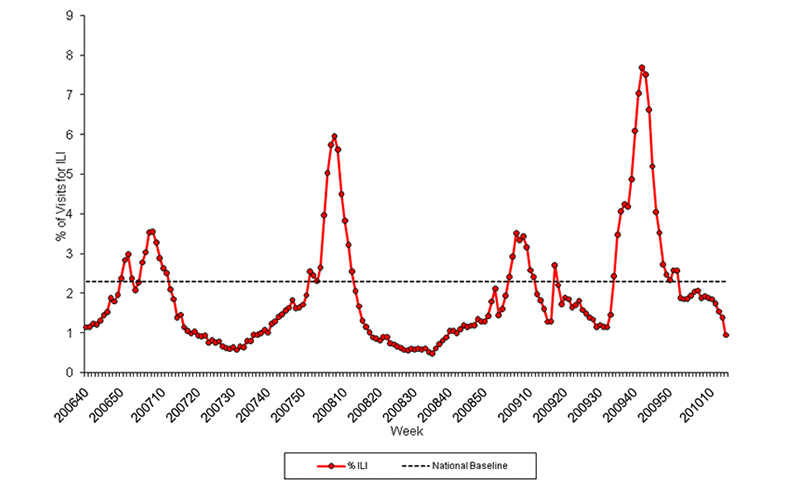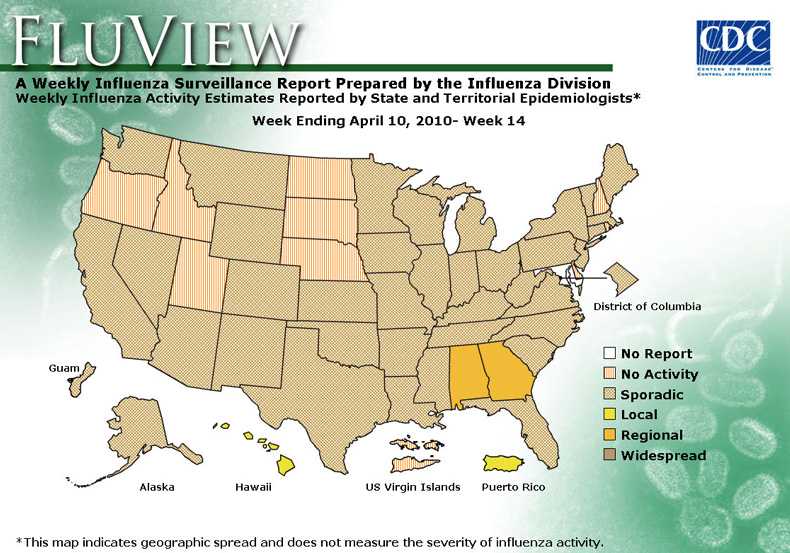Content on this page was developed during the 2009-2010 H1N1 pandemic and has not been updated.
- The H1N1 virus that caused that pandemic is now a regular human flu virus and continues to circulate seasonally worldwide.
- The English language content on this website is being archived for historic and reference purposes only.
- For current, updated information on seasonal flu, including information about H1N1, see the CDC Seasonal Flu website.
2009 H1N1 Flu U.S. Situation Update
April 16, 2010, 1:30 PM ET
Map: Weekly Influenza Activity Estimates Reported by State and Territorial Epidemiologists
(Activity levels indicate geographic spread of both seasonal and 2009 influenza A [H1N1] viruses)
(Posted April 16, 2010, 1:30 PM ET, for Week Ending April 10, 2010)
For information about how this map is updated, see Questions & Answers About CDC's Online Reporting.
Percentage of Visits for Influenza-like Illness (ILI) Reported by the U.S. Outpatient Influenza-like Illness Surveillance Network (ILINet), National Summary 2008-2009 and Previous Two Seasons
(Posted April 16, 2010, 1:30 PM ET, for Week Ending April 10, 2010)

As of April 16, 2010, the Aggregate Hospitalizations and Deaths Reporting Activity (AHDRA) has concluded for the 2009-2010 flu season. The AHDRA surveillance system was created specifically in response to the 2009 H1N1 pandemic, and the system will be maintained for quick implementation in the event of another flu pandemic. CDC will continue to track hospitalizations and deaths through its traditional seasonal flu surveillance systems during the 2010-2011 season. Pneumonia and influenza-related deaths in adults and children will be tracked through the 122 Cities Mortality Reporting System. Laboratory confirmed, flu-related deaths in children will continue to be tracked through the Influenza-associated Pediatric Mortality Surveillance system. Laboratory confirmed, flu-related hospitalizations in adults and children will be tracked through the Emerging Infections Program (EIP). |
*Reports can be based on syndromic, admission or discharge data, or a combination of data elements that could include laboratory-confirmed and influenza-like illness hospitalizations.
*Laboratory confirmation includes any positive influenza test (rapid influenza tests, RT-PCR, DFA, IFA, or culture), whether or not typing was done.
The table shows aggregate reports of all laboratory confirmed influenza hospitalizations and deaths (including 2009 H1N1 and seasonal flu) since August 30, 2009 received by CDC from U.S. states and territories**. This table will be updated weekly each Friday at 11 a.m. For the 2009-2010 influenza season, states are reporting based on new case definitions for hospitalizations and deaths effective August 30, 2009.
CDC will continue to use its traditional surveillance systems to track the progress of the 2009-2010 influenza season. For more information about influenza surveillance, including reporting of influenza-associated hospitalizations and deaths, see Questions and Answers: Monitoring Influenza Activity, Including 2009 H1N1.
The number of 2009 H1N1 hospitalizations and deaths reported to CDC from April – August 2009 is available on the Past Situation Updates page.
For state level information, refer to state health departments.
International Human Cases of 2009 H1N1 Flu Infection
See: World Health Organization.
**States report weekly to CDC either 1) laboratory-confirmed influenza hospitalizations and deaths or 2) pneumonia and influenza syndrome-based cases of hospitalization and death resulting from all types or subtypes of influenza. Although only the laboratory confirmed cases are included in this report, CDC continues to analyze data both from laboratory confirmed and syndromic hospitalizations and deaths.
Date Reported |
Laboratory-Confirmed 2009 H1N1 Influenza Pediatric Deaths |
Laboratory-Confirmed Influenza A Subtype Unknown Pediatric Deaths |
Laboratory-Confirmed Seasonal Influenza |
Total |
|---|---|---|---|---|
| This Week (Week 14, April 4 - April 10, 2010) | 1 | 1 | 1 | 3 |
| Since August 30, 2009 | 221 | 50 | 1 | 272 |
| Cumulative since April 26, 2009 | 281 | 53 | 3 | 337 |
This table is based on data reported to CDC through the Influenza-Associated Pediatric Mortality Surveillance System. Influenza-associated deaths in children (persons less than 18 years) was added as nationally notifiable condition in 2004. For more information about influenza-associated pediatric mortality, see FluView. |
||||



